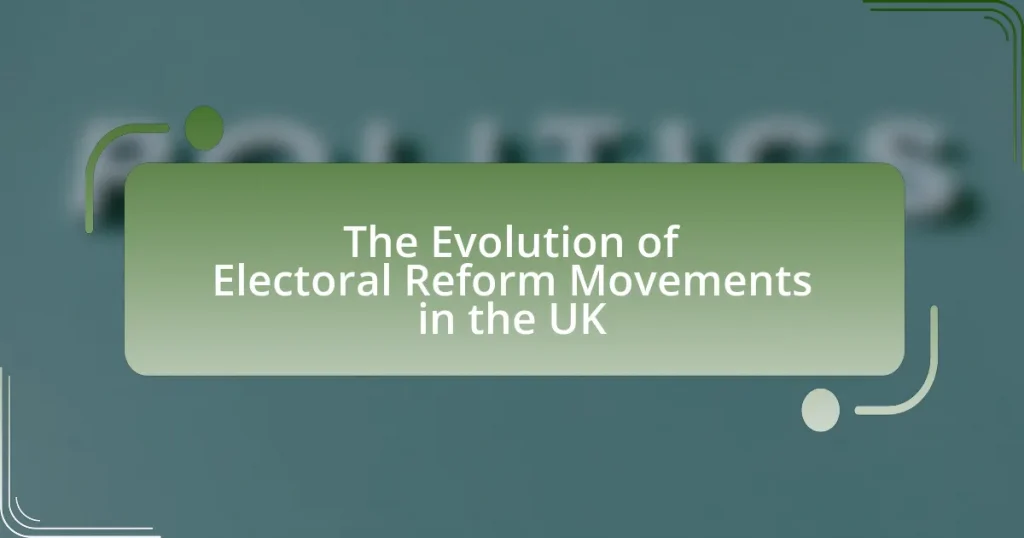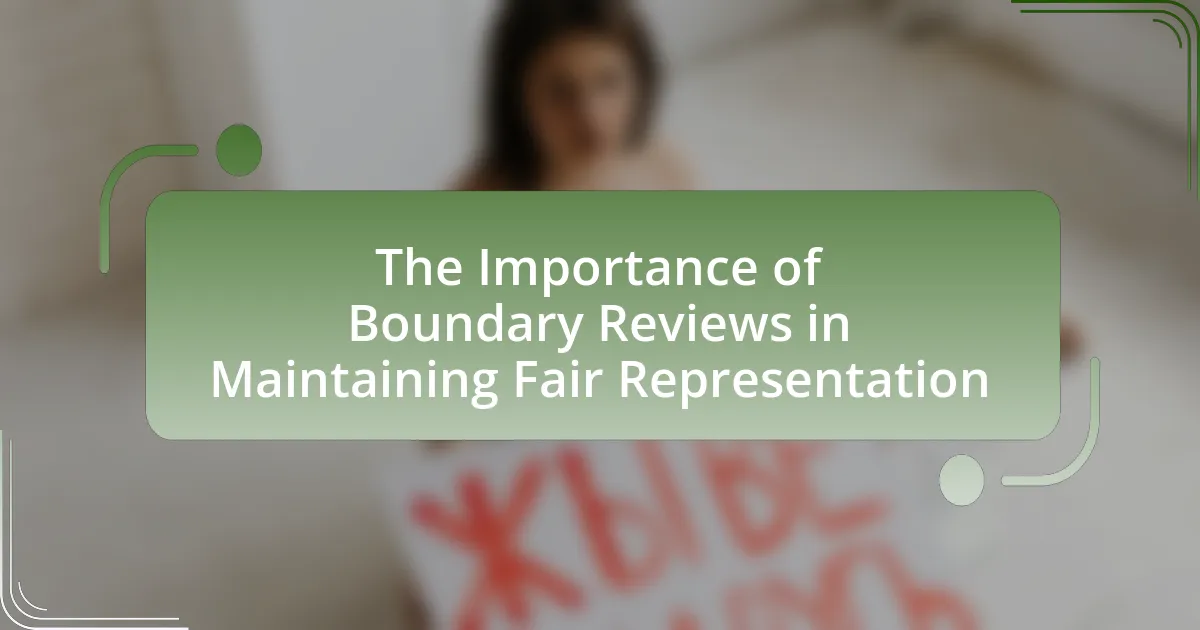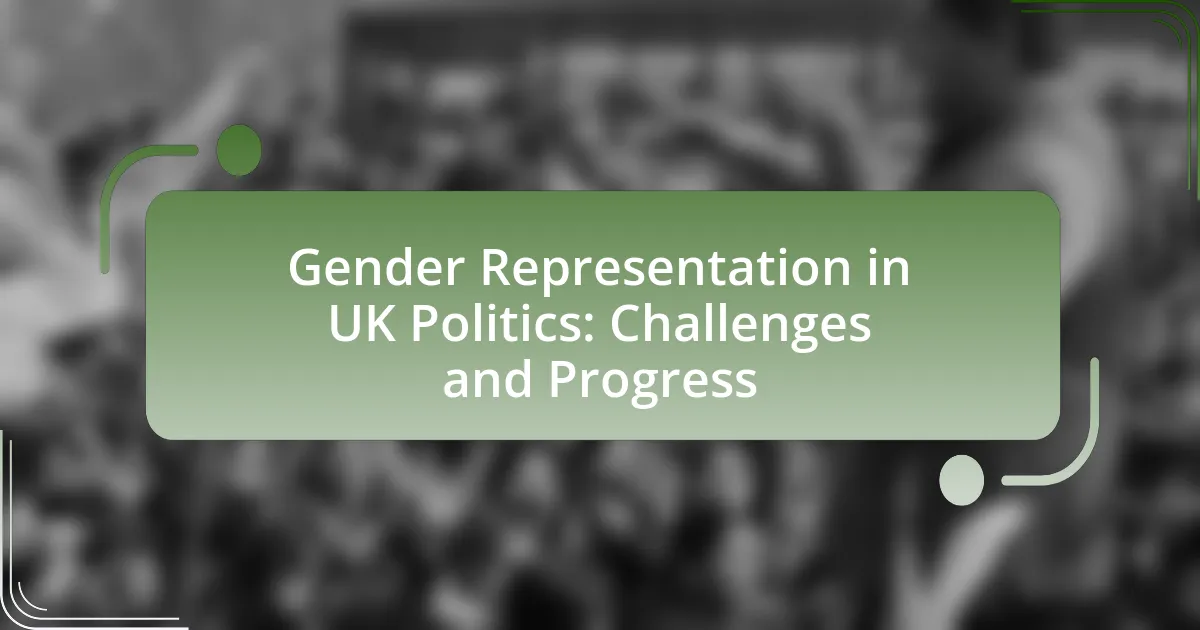Electoral reform movements in the UK are organized efforts aimed at changing the electoral system to enhance democratic representation and fairness. Historically, these movements have focused on expanding voting rights, advocating for proportional representation, and reforming the House of Lords, with significant milestones including the Reform Acts of the 19th century and the Suffragette movement. The article explores the evolution of these movements, key historical events that influenced electoral reform, public opinion’s role, and contemporary challenges faced by reform advocates. It also discusses specific objectives and proposed changes, such as ranked-choice voting and lowering the voting age, reflecting the electorate’s needs for a more inclusive and representative system.
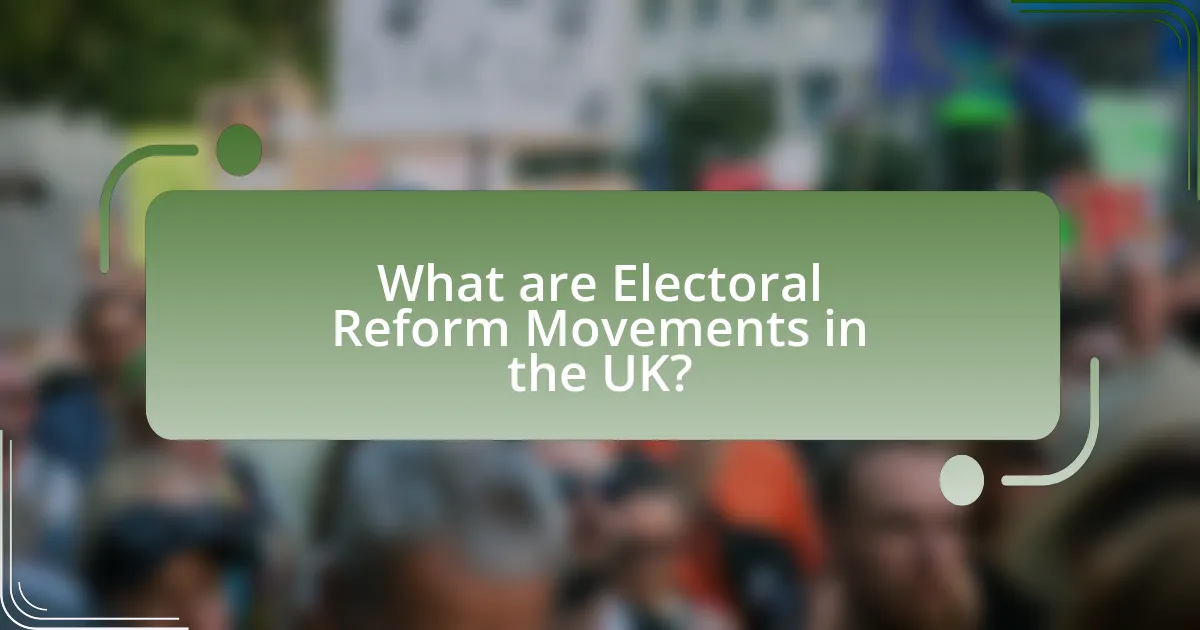
What are Electoral Reform Movements in the UK?
Electoral reform movements in the UK are organized efforts aimed at changing the electoral system to improve democratic representation and fairness. These movements have historically sought various reforms, including the introduction of proportional representation, the extension of voting rights, and the reform of the House of Lords. Notable examples include the Chartist movement in the 19th century, which advocated for universal male suffrage, and the more recent campaigns for the Alternative Vote and proportional representation, reflecting ongoing public demand for a more equitable electoral process. The existence of these movements is evidenced by significant legislative changes, such as the Representation of the People Acts, which expanded voting rights and reformed electoral processes throughout the 20th century.
How have these movements evolved over time?
Electoral reform movements in the UK have evolved significantly from the early 19th century to the present day. Initially, these movements focused on expanding the franchise, as seen in the Reform Acts of 1832, 1867, and 1884, which progressively extended voting rights to more men and, eventually, women. The suffragette movement in the early 20th century marked a pivotal shift, emphasizing gender equality in voting rights, culminating in the Representation of the People Act 1918, which granted voting rights to women over 30.
In recent decades, electoral reform movements have shifted towards advocating for proportional representation and addressing issues like voter disenfranchisement and electoral integrity. The 1997 Labour government introduced the Human Rights Act and devolution, reflecting a response to calls for more democratic representation. Additionally, the 2011 Alternative Vote referendum highlighted ongoing debates about electoral systems, although it ultimately failed to change the status quo.
These movements have adapted to changing political landscapes and societal values, demonstrating a continuous push for a more inclusive and representative electoral system in the UK.
What key historical events influenced electoral reform in the UK?
Key historical events that influenced electoral reform in the UK include the Reform Acts of 1832, 1867, and 1884, which progressively expanded the electorate and reformed voting practices. The 1832 Reform Act addressed the representation of industrial cities and reduced property qualifications for voting, increasing the number of eligible voters from about 400,000 to 800,000. The 1867 Reform Act further extended the franchise to urban working-class men, doubling the electorate again. Finally, the 1884 Reform Act extended voting rights to rural working-class men, bringing the total electorate to approximately 2.5 million. These acts collectively laid the groundwork for modern democratic practices in the UK.
How did public opinion shape the direction of these movements?
Public opinion significantly influenced the direction of electoral reform movements in the UK by mobilizing support for change and pressuring lawmakers to respond to the demands of the populace. For instance, the Reform Act of 1832 was largely driven by widespread public agitation, including protests and petitions, which highlighted the need for broader representation and addressed the grievances of the middle class and working population. This public pressure was evident in the mass mobilization of groups like the Chartists in the 1830s and 1840s, who advocated for universal suffrage and other democratic reforms, demonstrating how collective public sentiment could shape legislative priorities. Additionally, surveys and public debates during the late 19th and early 20th centuries reflected changing attitudes towards voting rights, further compelling political leaders to consider reforms that aligned with the evolving views of their constituents.
What are the main objectives of electoral reform movements?
The main objectives of electoral reform movements are to enhance democratic participation, ensure fair representation, and improve the integrity of electoral processes. These movements aim to address issues such as gerrymandering, voter suppression, and outdated voting systems, which can distort electoral outcomes. For instance, the Representation of the People Act 1918 in the UK expanded voting rights to include women over 30 and all men over 21, reflecting a significant shift towards inclusivity and fairness in the electoral process. Additionally, electoral reform movements often advocate for measures like proportional representation, which can lead to a more accurate reflection of public preferences in elected bodies.
What specific changes do these movements advocate for?
Electoral reform movements in the UK advocate for specific changes such as proportional representation, the reduction of the voting age, and the introduction of ranked-choice voting. Proportional representation aims to ensure that the number of seats held by a party in Parliament reflects the percentage of votes they receive, addressing the disproportionality of the current first-past-the-post system. The reduction of the voting age to 16 is supported to engage younger citizens in the democratic process, as seen in Scotland where 16-year-olds can vote in local and national elections. Additionally, ranked-choice voting is proposed to allow voters to rank candidates in order of preference, which can lead to more representative outcomes and reduce the impact of tactical voting. These changes are supported by various studies and reports, including the Electoral Reform Society’s findings on the benefits of proportional representation in enhancing democratic legitimacy.
How do these objectives reflect the needs of the electorate?
The objectives of electoral reform movements in the UK directly reflect the needs of the electorate by aiming to enhance representation, increase voter participation, and ensure fairness in the electoral process. These movements have historically sought to address issues such as disenfranchisement and unequal voting power, which are critical concerns for voters. For instance, the introduction of the Representation of the People Act 1918 expanded the electorate significantly by granting voting rights to women over 30 and all men over 21, directly responding to the demand for inclusive representation. Additionally, the push for proportional representation in recent years aligns with the electorate’s desire for a voting system that accurately reflects diverse political views, as evidenced by public opinion polls indicating widespread support for such reforms.
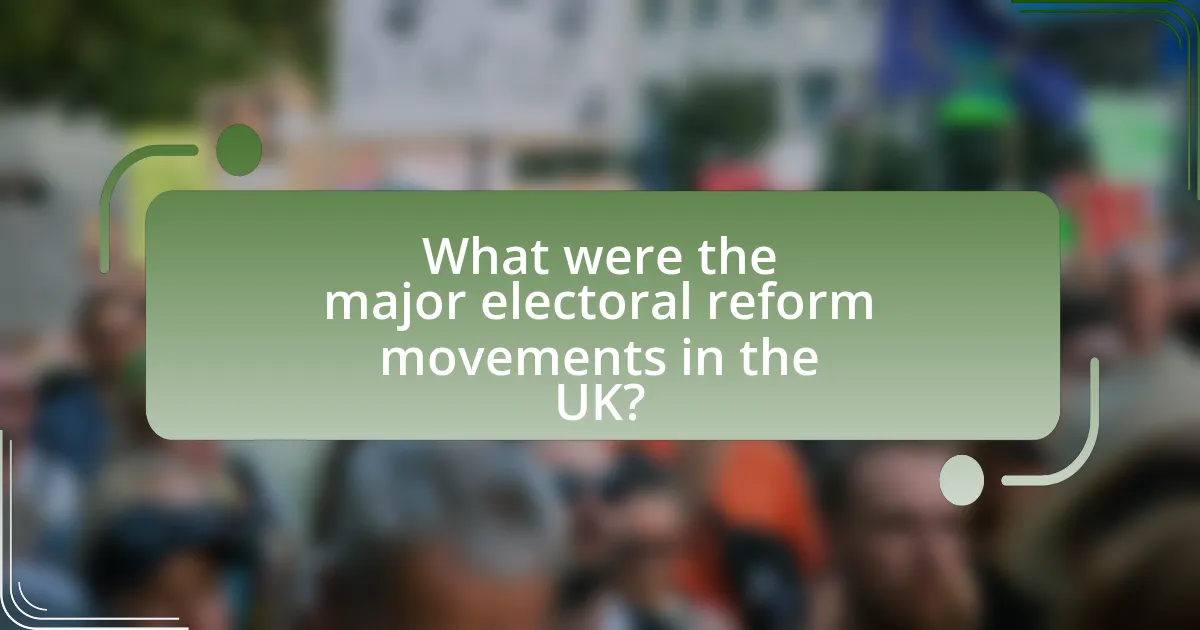
What were the major electoral reform movements in the UK?
The major electoral reform movements in the UK include the Reform Acts of 1832, 1867, and 1884, which progressively expanded the electorate and reformed voting practices. The Reform Act of 1832 addressed the representation of industrial cities and eliminated “rotten boroughs,” increasing the number of voters from about 400,000 to 800,000. The Reform Act of 1867 further extended the franchise to urban working-class men, doubling the electorate to approximately 1.5 million. The Reform Act of 1884 expanded voting rights to rural working-class men, increasing the electorate to around 5 million. These movements collectively aimed to make the electoral system more democratic and representative of the population.
How did the Reform Acts of the 19th century impact electoral reform?
The Reform Acts of the 19th century significantly advanced electoral reform by expanding the electorate and redistributing parliamentary representation. The First Reform Act of 1832 increased the number of eligible voters by lowering property requirements, allowing more middle-class men to vote, and it also eliminated “rotten boroughs,” which were underrepresented areas. The Second Reform Act of 1867 further broadened the electorate by enfranchising urban working-class men, effectively doubling the number of voters. Finally, the Third Reform Act of 1884 extended voting rights to rural working-class men, solidifying the principle of universal male suffrage. Collectively, these acts transformed the British electoral landscape, making it more representative and laying the groundwork for future reforms.
What were the key features of the Reform Acts?
The key features of the Reform Acts include the expansion of the electorate, the redistribution of parliamentary seats, and the introduction of secret ballots. The Reform Act of 1832 significantly increased the number of eligible voters by lowering property requirements, allowing more middle-class men to vote. Subsequent acts, such as the Reform Act of 1867, further extended voting rights to urban working-class men, while the Reform Act of 1884 expanded suffrage to rural workers. Additionally, the Redistribution of Seats Act of 1885 reallocated parliamentary seats to better represent population changes, addressing disparities in representation. The introduction of the secret ballot in the Ballot Act of 1872 aimed to reduce electoral corruption and intimidation, ensuring that voters could cast their votes privately. These features collectively transformed the electoral landscape in the UK, making it more democratic and representative.
How did these acts change voter demographics?
The acts significantly altered voter demographics by expanding the electorate to include previously disenfranchised groups. For instance, the Representation of the People Act 1918 enfranchised all men over the age of 21 and women over the age of 30, increasing the number of eligible voters from about 7.7 million to 21 million. This act marked a pivotal shift, as it allowed women to participate in elections for the first time, thereby diversifying the voter base. Subsequent reforms, such as the Representation of the People (Equal Franchise) Act 1928, further equalized voting rights by lowering the voting age for women to 21, resulting in a more balanced demographic representation in the electorate. These legislative changes collectively transformed the political landscape, making it more inclusive and reflective of the broader population.
What role did the Suffragette movement play in electoral reform?
The Suffragette movement played a crucial role in advancing electoral reform by advocating for women’s right to vote, which ultimately led to significant legislative changes. The movement, particularly active in the early 20th century, mobilized public opinion and pressured the government through protests, hunger strikes, and civil disobedience. Their efforts culminated in the Representation of the People Act 1918, which granted voting rights to women over the age of 30 who met minimum property requirements, marking a pivotal shift in electoral policy. This act was a direct result of the relentless campaigning and societal pressure exerted by Suffragettes, demonstrating their essential influence on the evolution of electoral reform in the UK.
What strategies did Suffragettes use to advocate for women’s voting rights?
Suffragettes employed militant tactics, public demonstrations, and political lobbying to advocate for women’s voting rights. They organized events such as marches and rallies to raise awareness and garner public support, exemplified by the 1913 Women’s Sunday march in London, which attracted over 40,000 participants. Additionally, they engaged in civil disobedience, including hunger strikes and property damage, to draw attention to their cause, notably the actions of Emmeline Pankhurst and the Women’s Social and Political Union. Their efforts were aimed at pressuring the government to recognize women’s suffrage, ultimately contributing to the Representation of the People Act 1918, which granted voting rights to women over 30 in the UK.
How did their efforts influence subsequent electoral reforms?
Their efforts significantly shaped subsequent electoral reforms by establishing foundational principles of representation and fairness. The advocacy for universal suffrage and the elimination of property qualifications led to the Representation of the People Acts, notably in 1918 and 1928, which expanded voting rights to women and working-class men. These reforms were direct outcomes of earlier movements that highlighted the need for a more inclusive electoral system, demonstrating how grassroots activism can lead to legislative change.
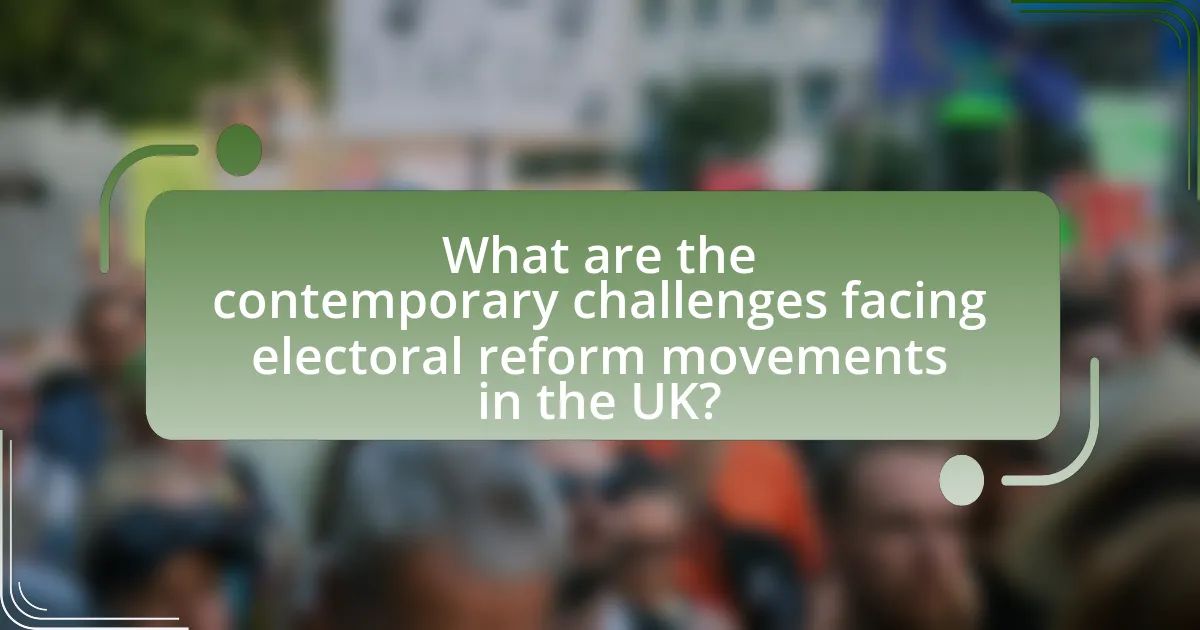
What are the contemporary challenges facing electoral reform movements in the UK?
Contemporary challenges facing electoral reform movements in the UK include political resistance, public apathy, and the complexity of the electoral system. Political resistance is evident as major parties often benefit from the current first-past-the-post system, making them reluctant to support reforms that could diminish their power. Public apathy is significant, with many citizens feeling disillusioned about the effectiveness of reforms, leading to low engagement in reform initiatives. Additionally, the complexity of the electoral system poses challenges, as proposed changes, such as proportional representation, require extensive public understanding and support to be implemented effectively. These factors collectively hinder the progress of electoral reform movements in the UK.
How do current political dynamics affect electoral reform efforts?
Current political dynamics significantly influence electoral reform efforts by shaping the priorities and strategies of political parties and stakeholders. For instance, the rise of populist movements and polarized political environments often leads to resistance against reform initiatives, as parties may prioritize maintaining their power over addressing systemic issues. Additionally, the ongoing debates surrounding Brexit have intensified discussions on electoral integrity and representation, prompting calls for reforms such as proportional representation. Evidence of this can be seen in the increased advocacy from various political groups and civil society organizations, which have gained traction in response to perceived inadequacies in the current electoral system.
What are the main political parties’ positions on electoral reform?
The main political parties in the UK have distinct positions on electoral reform. The Labour Party generally supports proportional representation, advocating for a system that reflects the diversity of voter preferences more accurately. The Conservative Party typically favors the current first-past-the-post system, arguing that it provides stable government and clear outcomes. The Liberal Democrats strongly advocate for electoral reform, specifically promoting the adoption of proportional representation to enhance democratic representation. The Green Party also supports proportional representation, emphasizing the need for a voting system that reflects the electorate’s views more equitably. These positions illustrate the ongoing debate surrounding electoral reform in the UK, with varying perspectives on how best to achieve fair representation in the political system.
How does public trust in the electoral system impact reform initiatives?
Public trust in the electoral system significantly influences reform initiatives by determining the level of public support for proposed changes. When citizens have confidence in the integrity and functionality of the electoral process, they are more likely to resist reforms, believing that the system is already effective. Conversely, low public trust can lead to increased demand for reforms, as citizens seek to address perceived injustices or inefficiencies. For instance, a 2020 survey by the Electoral Commission found that only 43% of respondents felt confident in the electoral process, correlating with heightened calls for reforms such as proportional representation and improved voter accessibility. This relationship illustrates that public trust directly shapes the momentum and direction of electoral reform movements in the UK.
What strategies can be employed to advance electoral reform today?
To advance electoral reform today, advocacy for proportional representation is essential. This strategy addresses the disproportionate representation seen in the current first-past-the-post system, which often leads to a mismatch between votes cast and seats won. Historical evidence from countries like Germany and New Zealand demonstrates that proportional representation can enhance voter engagement and satisfaction, as it allows for a broader spectrum of political views to be represented in parliament. Additionally, grassroots mobilization and public awareness campaigns can galvanize support for reform, as seen in the successful campaigns for the Alternative Vote in 2011, which, despite not passing, raised significant public discourse around electoral systems. Engaging with political parties to include electoral reform in their platforms can also create a pathway for legislative change, as demonstrated by the Labour Party’s commitment to reform in their 2019 manifesto.
How can grassroots movements effectively influence policy change?
Grassroots movements can effectively influence policy change by mobilizing community support, raising awareness, and leveraging social media to amplify their message. These movements often engage in direct action, such as protests and petitions, which can draw public attention and pressure policymakers to respond. For instance, the UK’s “People’s Vote” campaign successfully galvanized public support for a second referendum on Brexit, demonstrating how grassroots efforts can shift political discourse and compel legislative action. Additionally, research indicates that grassroots organizations that build coalitions with established advocacy groups can enhance their impact, as seen in the collaboration between various civil rights organizations during the 2010s in the UK.
What role does technology play in modern electoral reform advocacy?
Technology plays a crucial role in modern electoral reform advocacy by enhancing communication, mobilization, and transparency. Digital platforms enable advocacy groups to reach a wider audience, facilitating grassroots movements and increasing public engagement in electoral issues. For instance, social media campaigns have been instrumental in raising awareness about electoral reforms, as seen in the UK where organizations like the Electoral Reform Society utilize online tools to disseminate information and gather support. Additionally, technology improves transparency through data collection and analysis, allowing advocates to present evidence-based arguments for reform, such as the use of online petitions that can demonstrate public support quantitatively.
What practical steps can individuals take to support electoral reform in the UK?
Individuals can support electoral reform in the UK by actively participating in advocacy groups that promote reform initiatives. Joining organizations such as the Electoral Reform Society allows individuals to engage in campaigns that push for changes like proportional representation, which has been shown to enhance voter representation and engagement. Additionally, individuals can contact their local MPs to express support for specific reform proposals, thereby influencing legislative priorities. Engaging in public discussions and raising awareness through social media platforms can also amplify the call for reform, as evidenced by the increased public discourse surrounding electoral issues in recent years. Furthermore, attending town hall meetings and participating in community forums provides opportunities to discuss electoral reform directly with decision-makers and fellow citizens.
